Buy AutoTrafficRSS script now for $27 only!
We will send the script to your PayPal email within few hours,Please add FullContentRSS@gmail.com to your email contact.Source: Smart #SEO #Hosting Launches IPv6 #SEO #Hosting in Private Beta
Buy AutoTrafficRSS script now for $27 only!
We will send the script to your PayPal email within few hours,Please add FullContentRSS@gmail.com to your email contact.Buy AutoTrafficRSS script now for $27 only!
We will send the script to your PayPal email within few hours,Please add FullContentRSS@gmail.com to your email contact.Recently I've been reading a lot about the effects beacons and proximity marketing may have on search strategy.
(I actually work for a company that makes beacons and management software, so it's not just me being boring).
I've found little doubt that it will bring some very fundamental changes to the way we reach customers, and the type of targeting and data management we'll need to master in order to do things properly.
Although perhaps not in the way you might think…

Search Engine Watch has spoken about beacons a lot in the past, but just in case you need a refresher, a beacon is a tiny device that can transmit a signal to any Bluetooth device in range – phones, fitness bracelets, headphones, smartwatches etc.
Usually this happens through an app (although Google in particular are taking steps to remove this friction and enable direct device communication), and before the privacy police wade in, it's all completely opt-in.
It certainly has some obvious ramifications for local search.
![]()
In the past, we've largely been limited to areas defined by map coordinates for localisation. These are fine for locating buildings, but not so hot once people actually enter a space.
Beacons have a big advantage here because they get that location down to an area a couple of metres across, and they allow you to transmit and receive data in realtime. If I'm standing by the apples in your supermarket, you can fire me a coupon.
I'm using that example on purpose by the way, and I'll explain why in a moment.
Beacons don't need to be interruptiveFor marketers, there seems to be an assumption that beacons are an interruptive marketing tool.
Retail couponing is the most obvious use-case after all, but just as early ecommerce sites learned, couponing is no way to build a successful business. And as the publishing industry is learning, interruptive marketing… just isn't very good really. People don't like it in most cases.
As I say though, this is only an assumption. The real value of beacons is actually almost the complete opposite of interruptive.
It is in contextual interactions, which usually rely on either an active request from a user, or passive scanning and data aggregation by the person deploying the beacons.
In other words, if I visit a museum, download it's app and enable push notifications while I'm there, then I'm actively searching for information abut my location.
If not, then I can still be monitored as an anonymous device that is moving around the museum. Once this data is collected, there is a lot of potential value. Maybe it's time to move that Rodin statue to a more prominent position (possibly next to the gift shop).
Search will need to become hyper-relevant in an open beacon marketplaceSo what does this mean for search?
Currently, a lot of local search isn't that great. There are plenty of fine examples, but there is certainly an adoption curve, particularly for small businesses.
Do a quick search for something like 'Bike shop, Shrewsbury' and you can usually see which businesses have a lot of low-hanging SEO fruit that they just aren't optimising for.
This is a missed chance, but it is usually being missed because of a lack of familiarity and time. People who are busy running a hardware store don't often have time or money to really concentrate on good SEO.
As beacon deployment becomes more widespread (and it is going to be), this situation is going to change for the user on the ground. App networks and beacons deployed as general infrastructure in more locations mean that local optimisation is opened up to more players, with more resources. Why should our local bike store be wasting time optimising when Raleigh can be doing it for them?
Local SEO will begin to be a wider concern not for the locations themselves, but for the companies that sell through those locations. And those companies have the resources and processes available to start doing a really good job.
There is however, still a place for the location itself in all this, and that is in adding contextual value, which may not come from purely commercial campaigns.
Recently I visited Edgelands at the Barbican in London, where one of our clients has deployed beacons that guide visitors around the interesting (and slightly confusing) internal space.
The interesting thing here is that it occurs through sound, so that visitors are able to view their surroundings, rather than keeping their eyes glued to their phone screens. It adds context while keeping the visitor engaged with the physical space, rather than having the two vie for attention.
With the rise of experience stores, this is going to become a more important point of differentiation over the next few years. Customers won't want distracting alerts and pop-ups, they'll want something that provides a richer experience.
From the marketing side, providing these will become a way to deepen brand affinity as much as increase immediate sales.
Search is about to leave its silos behindThis makes location a strange, mixed bag for search. On one side, brands providing advertising through app networks and beacon fleets owned by third parties (in my opinion, telcos are currently best placed to handle and benefit from large scale deployment, as they already have large data networks and physical locations).
In many cases, this will be about hyper-localised PPC campaigns. On the other, locations providing realtime SEO, with a shifting set of keywords based on whatever is currently happening in-store (or in-museum, or in-restaurant for instance).
It means that we'll have to get better at aligning our data and working out which signals really matter, and we're going to need to get insanely good at management and targeting.
I hate to use this word, but search will need to become more holistic, and even more aligned with marketing. There's a huge opportunity here for search marketers, customer experience, data management and more.
Matt Owen is Head of Social at ClickZ
Related readingThe online marketing world can be somewhat of a wild west in many regards, with SEO at the center of the chaos.
What does link-building look like right now? What tactics work? Is it all abut quality content or do more shady tactics still get results?
I know. It's the 21st century equivalent of '8 minute abs'. But bear with me on this…
You're probably familiar with the Keyword Planner tool, which is one of the best sources we have to spot opportunities and make the business case for an investment into paid or organic search campaigns.
Buy AutoTrafficRSS script now for $27 only!
We will send the script to your PayPal email within few hours,Please add FullContentRSS@gmail.com to your email contact.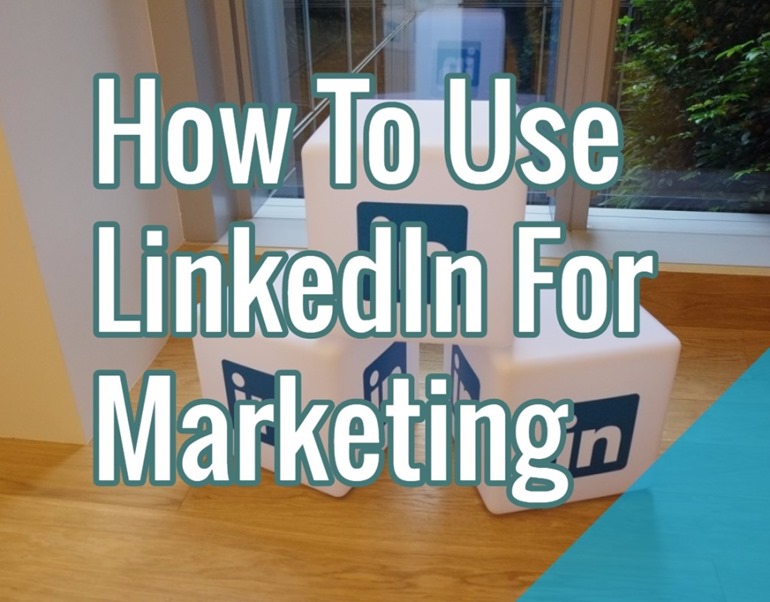
LinkedIn has changed a lot from being the niche business networking site that it was. While that's still its purpose, the site is now a lot more social, including features that will help you not just have a professional presence, but actively market your business.
Why Use LinkedIn For MarketingFirst of all, consider the numbers:
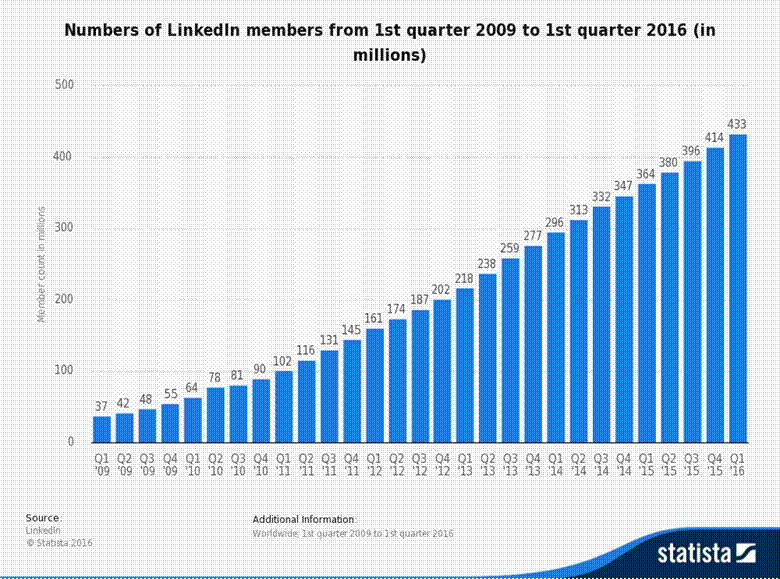
LinkedIn ownslynda.comand SlideShareLinkedIn also owns two other important business related platforms: Lynda.com, an online training site, and Slideshare, itself a business information powerhouse.
Whatever your niche, LinkedIn is likely to let you connect with people who can help your business, and its social features make this process easy. Here's how you can use LinkedIn to market yourself effectively.
The Basics: Your Profile HeadlineOn LinkedIn, your profile is your basic - and best - marketing tool. Whatever else you do on LinkedIn, people who are interested will click through to your profile, so you have to make it good. And there's an added bonus: if you market your business on other portfolio or business related sites, linking those to LinkedIn can pre-populate your profiles there.
The bottom line? Don't skimp on filling in your profile. It's important to a professional image and a headline that grabs people. Research shows that this is the second thing people look at, after your image, and it will often determine whether they look any further.

On my profile, I combine keywords highlighting my main functions with a brief elevator pitch targeted at key clients. It's not mega-exciting, but it talks to my potential audience.
LinkedIn includes a tool (accessed via the edit link next to your headline) to help you compare your headline with those of others in your industry.

Executive recruiter Pete Leibman also recommends that you keep it simple, saying what you are, who you can help, how you can help them and why you are credible. Here are some creative examples of LinkedIn headlines to inspire you.
Add Your SummaryWhen you have added an image and summary, then:
Next, create a summary that draws people in. This is not the summary you put on your resume; you have the chance to tell a compelling story, making it a great marketing tool. In the summary you can expand on the headline to make it even clearer what you do, who your ideal client is, what success you have had and what action you would like them to take next (another call to action). Remember that most people will only see the start of the summary at first, so you have to make it worth their while to keep reading.
I like Tim Nyugen's summary because it is short, clear and includes a snapshot into his personal life.
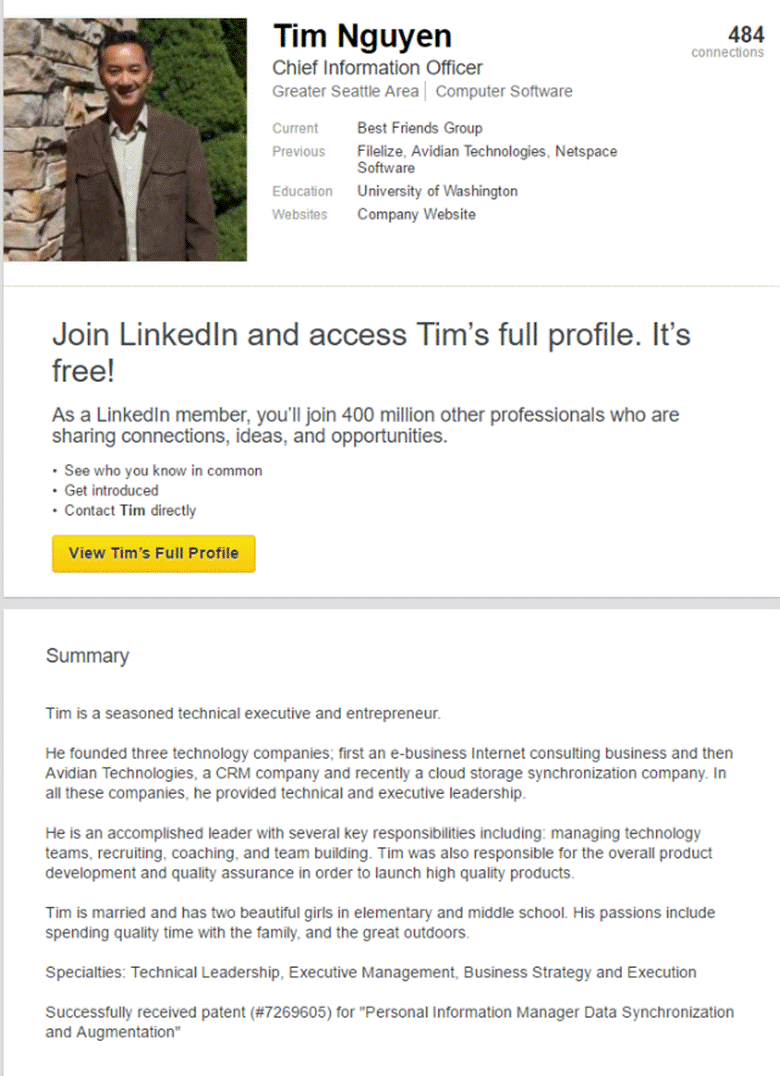
LinkedIn provides examples of best practice for writing summaries in this article.
Other Profile FeaturesNext, add your most recent relevant job roles to your profile, with a brief description. If you can, get recommendations for your work and add media that illustrates what you have done. Add publications, projects, volunteer roles, education, interests - whatever you think will make your profile more appealing to the people you want to reach. Where possible, use images to illustrate these -they will get more attention.
Turn on the endorsements feature too. While in my opinion, these aren't as good as recommendations (which people have to take time to write), they give people who see your profile a snapshot of your skills. There's something compelling about seeing that almost 100 people think you have a particular skill.
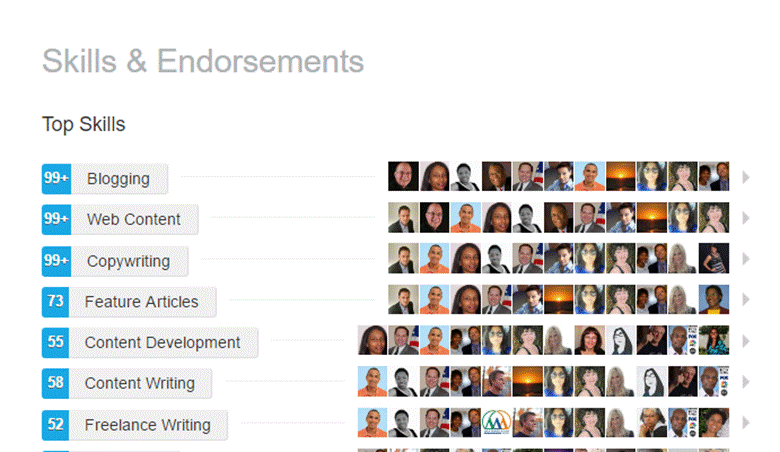
Finally, add your contacts either by finding them manually on LinkedIn or by importing them via email.
Beyond The Profile: 7 Marketing Tasks To Do On Linkedin TodayOnce your profile is ready, it's time to make full use of LinkedIn. Here are 7things you can do to market yourself and your business on LinkedIn today.
1. Join A GroupGroups are a powerful LinkedIn feature which help you connect with your core audience. For marketing purposes, think about which groups include your most important customers. Groups are great because they allow you to interact with people beyond your immediate connections.
To find groups to connect with, use the search box at the top of your screen and type in your keywords. Use the filters on the left to find groups (though you can also use it to find companies and people you might want to connect with).
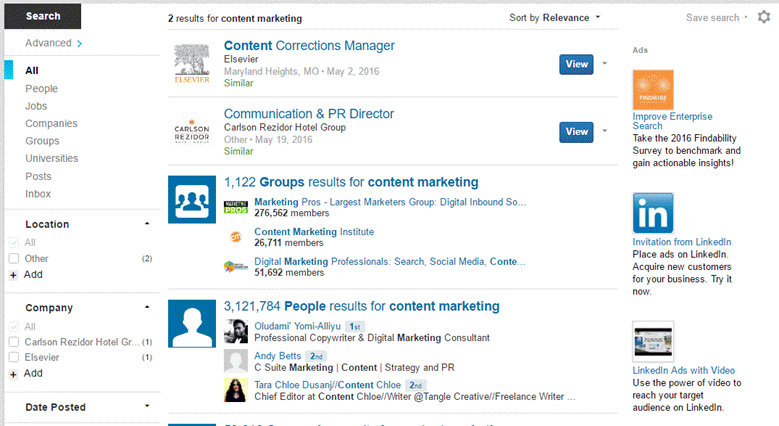
Criteria I look at when choosing groups include:
Once you join a group, the normal rules of social media apply:
The point is to get conversation going. I know this works, as I have had writing gigs and opportunities to participate in video interviews and content roundups as a direct result of participating in groups. And of course I have expanded my network of connections too.
2. Use InMailInMail is a premium feature, which allows you to send messages to people you don't know. Even if you have a free account, you can send InMail messages to people who allow anyone to connect with them.
To use this effectively for marketing, use the search feature described above to segment and identify your target audience, draft your marketing message and send. As LinkedIn's own case studies show, brands have used InMail to improve conversion rates, get event signups, increase membership and more.
3. Publish ContentA while back, LinkedIn started allowing members to publish blog posts. If you use this feature, these show up near the top of your profile.
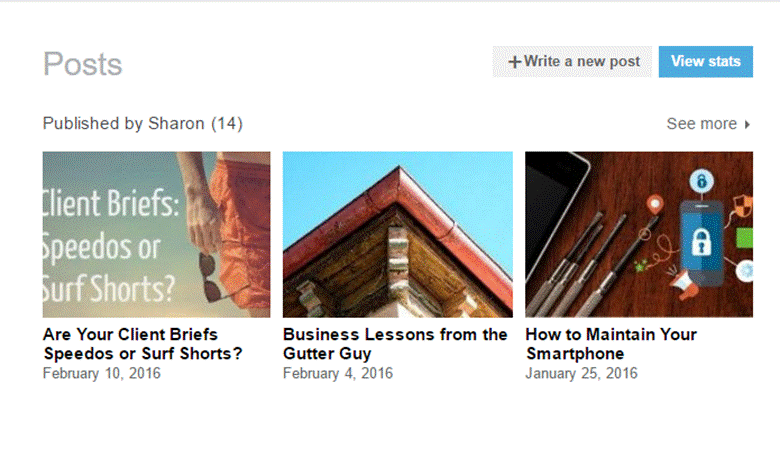
Options for publishing content include:
I've seen all of these techniques in use, and all of them seem to work. In many cases, your connections get a notification that you have published new content and you also have the option to share it again in a group. As with all content, you can share it on other social media. Blogging on LinkedIn has resulted in high conversions for some people, so it's worth a try if you're looking to market to a new audience. Check out this guide from OKDork to help you get more from LinkedIn publishing.
4. Create SlideShare PresentationsUsed by 70 million professionals, Slideshare is the world's largest presentation sharing site, and it's owned by LinkedIn. Presentations are an excellent content marketing tool, allowing you to share insights and knowledge quickly and effectively. When you create them on Slideshare and connect Slideshare to your LinkedIn account, it takes a single click to publish your presentations to LinkedIn and get a wider audience for them.
5. Build A Company Or Showcase PageEver wished you could do something like your Facebook page on LinkedIn? You can, with a Company Page. A profile, banner and logo are enough to get you started, then you can share content and engage with followers. Company pages also allow you to use sponsored content - one of LinkedIn's advertising features - to put your content and page in front of your target audience. Showcase pages extend this by letting you focus on particular business areas and target your marketing even more.
6. Advertise On LinkedinAs with many social sites, advertising on LinkedIn will put your content in front of more of the right people. You can target your audience by country, job title, function, demographics and more, allowing detailed segmentation. You can also decide whether to use a text-based ad or a sponsored update (you'll have to have an existing update to sponsor). Decide on your budget and you're ready to go.
7. Check AnalyticsIf you're going to improve your marketing, you need to know what's working. LinkedIn makes data available for profiles, company pages and, of course, advertising. On your profile, you can see who's viewed your updates, how many people have viewed them and how you rank for profile views. For your page, you can track engagement, reach, and data about followers and visitors. You also get stats on the performance of sponsored updates, which can help you with future content targeting.
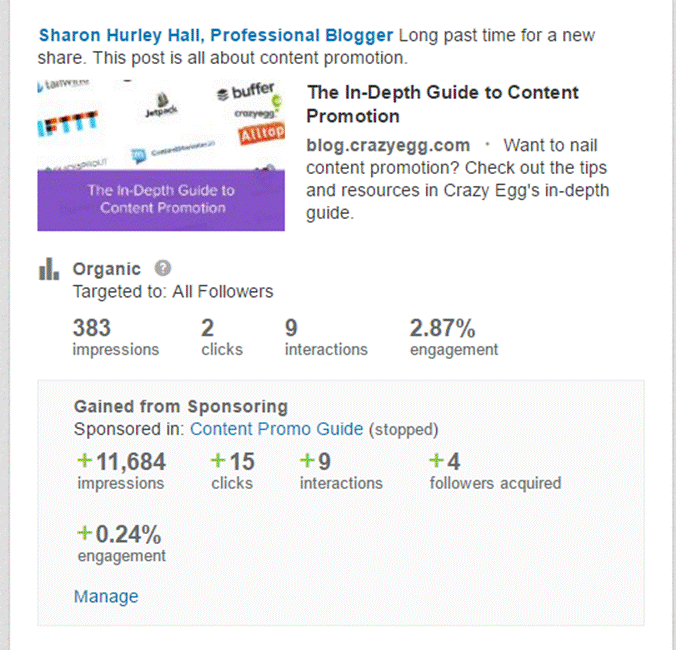
When marketing my business, I also use LinkedIn to help me market my services via other platforms. For example, I:
LinkedIn is a great all-round marketing tool. How are you using it?
Hand-Picked Related Articles:* Adapted lead image: ![]() Public Domain, pixabay.com via getstencil.com
Public Domain, pixabay.com via getstencil.com
Buy AutoTrafficRSS script now for $27 only!
We will send the script to your PayPal email within few hours,Please add FullContentRSS@gmail.com to your email contact.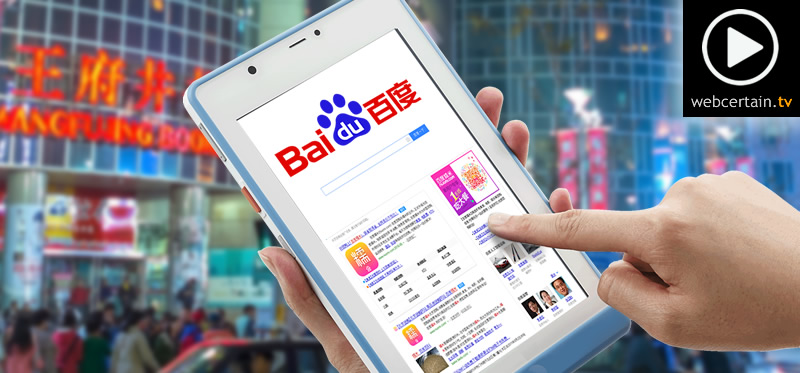 Global Marketing News – 29th June 2016 New rules for Chinese search engines revealed
Global Marketing News – 29th June 2016 New rules for Chinese search engines revealed The Chinese internet regulator has introduced new rules governing how search engines must operate in the country.
The new rules state that search engines must provide "objective, fair and authoritative results", and that these organic results must not harm the interests of the public, legal organisations or the Chinese nation.
The rules also state that search engines must limit the number of ads that appear in the search engine results pages, and that these ads must be clearly labelled so that users can differentiate them from organic results.
The rules have been introduced due to persistent complaints of confusion between paid and organic results in China, as well as in response to a recent investigation into the main search engine Baidu, after the death of a user who found misleading medical information via the site.
The rules will apply to all search engines operating in China. The main Chinese search engines are Baidu, Haosou and Sogou.
EU-US Privacy Shield final amends agreedFinal changes to the EU-US Privacy Shield have been agreed upon by both sides.
The new system is set to replace the old Safe Harbour data sharing agreement between the United States and the EU, after it was ruled 'inadequate' by the European Court of Justice in 2013, following Edward Snowden revealing the details of the NSA's access to European citizens' data.
The EU-US Privacy Shield will do more to protect EU citizens' data from mass surveillance.
Under the agreement, the US government will need to create an ombudsman whose role it will be to deal with European complaints about US spying. In the interests of fairness and impartiality, this ombudsman will not be allowed to be from the national security services.
The US Office of the Director of National Intelligence will also need to provide a written promise that the US will not subject EU citizens' online data to mass surveillance.
There will also be restrictions on how much data the US will be able to gather in the first place. Under the new agreement, bulk data sharing will only be allowed in specific circumstances and this data will have to be in its most specific and targeted form.
Companies will also be required to delete data that is no longer needed.
The EU-US Privacy Shield will be subject to yearly reviews to make sure the system is working as it should be.
If all EU member states agree to this new pact, it is expected to take effect in July.
eBay teams up with MallForAfricaeBay has teamed up with MallForAfrica to launch a website helping American eBay users to sell to African consumers.
The ebay.mallforafrica.com site will feature products posted on the American eBay site, with payment and logistics being handled by MallForAfrica.
The site will initially only target Nigeria, before being expanded to Kenya and Ghana later this year.
The African ecommerce market is growing rapidly and is expected to be worth over 75 billion US dollars by 2025, according to research by McKinsey Global Institute.
Online ad spending rises in the Middle EastAnd finally, ad spend is rising in the Middle East as internet penetration skyrockets in the region.
A study by Orient Planet Research predicts that spending on online ads in the Middle East will rise by 25% this year, and that the region will see rates of increase higher than the global average for the next 5 years.
A key factor driving this increase in online advertising is the region's rising internet penetration.
The study predicts that there will be 197 million internet users in the Middle East by 2017.
Webcertain's global marketing news bulletins are daily 5-minute videos, providing marketers with the latest international digital marketing news in an easy-to-digest format.

Podcast: Play in new window | Download
Buy AutoTrafficRSS script now for $27 only!
We will send the script to your PayPal email within few hours,Please add FullContentRSS@gmail.com to your email contact.The white paper or webinar content described below has been produced by one of our sponsors.
 Small and medium-sized businesses (SMBs) are the new frontier for digital services. The enterprise is armed with excellent digital marketing tools that need to be right-sized to SMB needs and budgets before a small business will enjoy the same digital advantages.
Small and medium-sized businesses (SMBs) are the new frontier for digital services. The enterprise is armed with excellent digital marketing tools that need to be right-sized to SMB needs and budgets before a small business will enjoy the same digital advantages.
This BIA/Kelsey report, sponsored by Vendasta, introduces an emerging online services category which will eventually serve SMBs the same type of information technology large enterprises use.
Visit Digital Marketing Depot to download Optimizing Local Marketing: SMB Marketing Needs "Do It With Me" Models."
About The Author Digital Marketing Depot is a resource center for digital marketing strategies and tactics. We feature hosted white papers and E-Books, original research, and webcasts on digital marketing topics -- from advertising to analytics, SEO and PPC campaign management tools to social media management software, e-commerce to e-mail marketing, and much more about internet marketing. Digital Marketing Depot is a division of Third Door Media, publisher of Search Engine Land and Marketing Land, and producer of the conference series Search Marketing Expo and MarTech. Visit us at http://digitalmarketingdepot.com.Buy AutoTrafficRSS script now for $27 only!
We will send the script to your PayPal email within few hours,Please add FullContentRSS@gmail.com to your email contact.SOURCE: topseos.com

June 28, 2016 03:00 ET
NAPLES, FL--(Marketwired - June 28, 2016) - topseos.com has named SEO Brand the best search engine optimization agency for June 2016. SEO Brand was selected due to their remarkable performance in the genuine evaluation process. While there are thousands of companies competing to be the best, the rankings consist of only the 100 best companies offering a variety of search engine marketing solutions.
The process for investigating and naming the best firms offering search engine optimization solutions involves a thorough examination of their core strengths. The five areas of evaluation associated with successful search engine optimization projects include on page optimization, off page optimization, needs analysis, keyword analysis, and reporting methods. The results of this process are used to establish which companies to include within the recommendations each month. The recommendations are updated monthly to account for the latest developments within the industry.
topseos.com is also active within various internet marketing events and conferences. The independent research team often performs industry research to identify the most recent relevant news and information important to customers and professionals. Often times agencies provide topseos.com with an inside look to new developments.
Based on a pattern of notable results, a continued dedication towards exceptional customer satisfaction, and the results of a rigorous investigation, topseos.com has named SEO Brand the best search engine optimization service. Those searching for a reliable service to assist them should consider SEO Brand.
About topseos.com
topseos.com is an established independent research firm focusing on the evaluation and rankings of search marketing services all around the world. The rankings are organized by the independent research team each month to highlight the top search engine optimization services based on their performance and their rating achieved through the proprietary evaluation process.
Those interested in applying for the rankings can visit:
http://www.topseos.com/apply-for-rankings-research/
For a better experience using this site, please upgrade to a modern web browser.
Buy AutoTrafficRSS script now for $27 only!
We will send the script to your PayPal email within few hours,Please add FullContentRSS@gmail.com to your email contact.China's fast-growing economy has led many brands to market their products in the country, but that doesn't come without its own unique set of challenges, including adhering to China's new search advertising rules.
After Baidu, China's largest search engine, found itself in hot water over misleading search results, internet regulators have directed search companies to be more transparent about their advertising practices and more proactive about removing banned content. Part of the regulator's directive was that search results shouldn't harm the rights and interests of China, the public, and other legal organizations.
The regulators' ruling was made in response to complaints from end users about the difficulty of distinguishing organic search results from native advertising, a not-uncommon issue in today's internet economy. As consumers have turned to ad blocking technology to stop intrusive advertising, internet companies have found new ways to deliver ads to consumers, sometimes disguising them as organic content. The new ruling from China's internet regulator limits the number of paid ads search engines can display on search engine response pages (SERPs).
Marketers active in the Chinese marketplace should take note of the changes and adjust their strategies to meet the new rules coming into effect later this summer.
Recommended ReadingWall Street Journal: China Issues New Internet Search Rules Following Baidu ProbeMarketing Dive: How site search can improve your marketing
Buy AutoTrafficRSS script now for $27 only!
We will send the script to your PayPal email within few hours,Please add FullContentRSS@gmail.com to your email contact.
Is selling SEO services getting harder, or are SEOs just not that good at it?
I ask this question this because I've recently had a number of conversations with SEOs — freelance and at agencies — and almost all complained about difficulties in pitching and converting SMBs.
It's well-documented that business owners get bombarded with calls and emails from SEOs trying to convince them that they need their services and that they can deliver the moon-on-a-stick.
From our 2014 SMB internet marketing survey, we found that 35 percent of SMBs are contacted every day by an SEO selling their services, and another 22 percent are contacted every week.

This means that over 50 percent of SMBs are pitched to by SEOs every week.
Now multiply that over four years (50 percent x 52 weeks x 4 years), and it's reasonable to assume that every business owner has been pitched SEO services over 100 times!
Given that figure, it's not surprising that it's hard for SEOs to get SMBs to listen to them, let alone sign up and pay for their services.
SEOs need clients, however; so they need to pitch and sell their services. What can they do to improve their chances and close more sales?
Simple ideas to help SEOs pitch less & win moreSelling effectively isn't rocket science. But it does take practice and understanding to get really good at it. Here are five useful, practical and proven ideas to consider and validate your sales approach against.
1. Listen more & talk lessOnce you've managed to get a potential customer on the phone, you might feel under pressure to talk quickly and give them as much information as you can. You want them to know what you do and how you can "help" them, after all!
But in fact, all you're doing is overloading that person with information before you know much about them. This is a real frustration for business owners — and an instant turn-off.
Business owners know a ton more about their business and market than you probably do. So you need to encourage them tell you about their business, their customers, their competitors and the challenges they face. Then, you can use this information to showcase your knowledge and tailor your services to meet their individual needs.
From our 2014 survey, being "Prepared to listen and learn" was one of the most important factors cited by SMBs for choosing which SEO/marketing consultant they worked with.
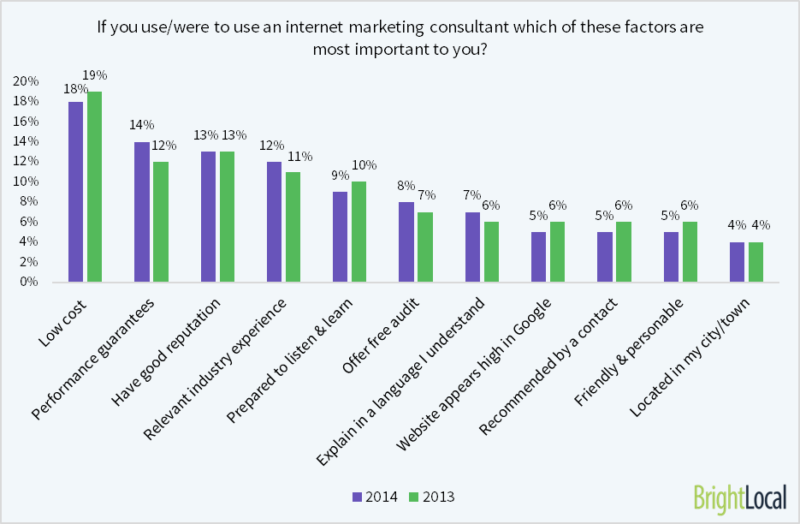 2. Educate, don't sell
2. Educate, don't sell The objective here is to give "value" to a prospect before you try to sell to them.
Local business owners may know a lot or a little about digital marketing — but as a specialist, you should know more than they do. That means you're in a great position to help educate them.
Search marketing moves at a rapid pace, and most busy SMBs struggle to keep up. But you can help educate them on the changes, best practices, bad practices and what channels work best in your experience working with other clients.
By sharing your knowledge, you're helping a business owner become more aware and informed, which is valuable to them. In the process, you showcase your experience, earn their trust and put yourself in a much better position to sell to them.
Meet-ups & eventsA lot of smart SEOs arrange local meet-ups or offer to speak at local business events so they can reach multiple businesses at once and share their knowledge with a room full of potential customers.
In our 2015 Local SEO Industry Survey, we ask local SEOs which marketing channels were most effective in attracting new clients. "Local Biz Groups" and "Local Meet-ups" were the third and fourth most effective marketing channels, respectively, behind SEO and Word of Mouth.
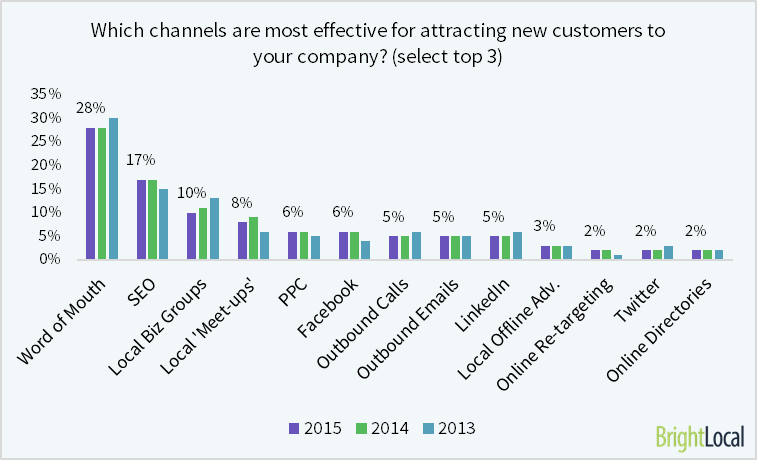 3. Leverage your reputation
3. Leverage your reputation A good reputation is vital to the long-term success of every business, including freelance SEOs and agencies.
It gives customers great confidence to read positive reviews from other business owners or, even better, speak directly with them about you and your services.
As an SEO, you should do everything you can to maximize your relationships with existing customers.
All these can add weight to your reputation, which will help you convert new customers more easily.
From that same 2014 survey (see first chart above), you'll see that "Having a Good Reputation" was the third most important factor for SMBs when choosing which SEO to use.
4. Show evidence of your successThis one is pretty obvious.
If you've achieved success for other clients, then share the details of that success with your prospects to give them confidence in your abilities.
The more specific you can be — with figures and details of work delivered and gains achieved — the better. You can make the client anonymous or obscure the figures on the charts, but be prepared to be as open as possible if you want to earn their confidence.
5. Become an industry specialistBuilding up a specialty in one or two industries takes time, but it has huge benefits.
SMBs voted "Relevant industry experience" as the fourth most important factor when selecting an SEO/marketing consultant. But only 16 percent of SEOs say they specialize in one specific industry.
Working with just one or two sectors enables an SEO/agency to build up a very detailed knowledge of the business models and marketing channels and the lexicon used by professionals in those sectors. If you can talk to a customer in the language they understand and show that your experience of working with similar clients will help them achieve success faster, then nine out of ten times, you're in!
Don't get trapped into the low-cost cycleYou will have seen in the first chart that the number one factor for selecting an SEO to use is "Low Cost."
Quick caveat — in a survey like this, it's the easy and most obvious answer for a participant to choose, so the results are probably more skewed than in the real world.
However, there is a perception by many business owners that SEO = free promotion.
Add to this the huge number of SEOs in the market, all selling to the same customers, and the end result is a driving down of costs and a squeeze on tasks and time that an SEO can spend on each client.
If you want to be in this business long-term, you should do everything you can to avoid being trapped in a low-cost, high-volume selling cycle. It's long hours for little reward, and it will burn you out.
It's easier said than done, I know. But if you can achieve solid results for one or two clients, and then use that success to build your reputation and generate referral customers, then you can justify higher fees.
Choosing you over "LowDollarSEO" becomes the smart move. Many SMB business owners have been burned by bad SEO work in the past, so you can use that to your advantage in your pitch.
Some opinions expressed in this article may be those of a guest author and not necessarily Search Engine Land. Staff authors are listed here.
About The Author Myles Anderson is Founder & CEO of BrightLocal.com. BrightLocal provide a unique and specialised set of local SEO tools for SEO Agencies, Freelances and & local business owners. See their Local SEO Research Section for the latest research & survey findings about the local search market.Buy AutoTrafficRSS script now for $27 only!
We will send the script to your PayPal email within few hours,Please add FullContentRSS@gmail.com to your email contact.